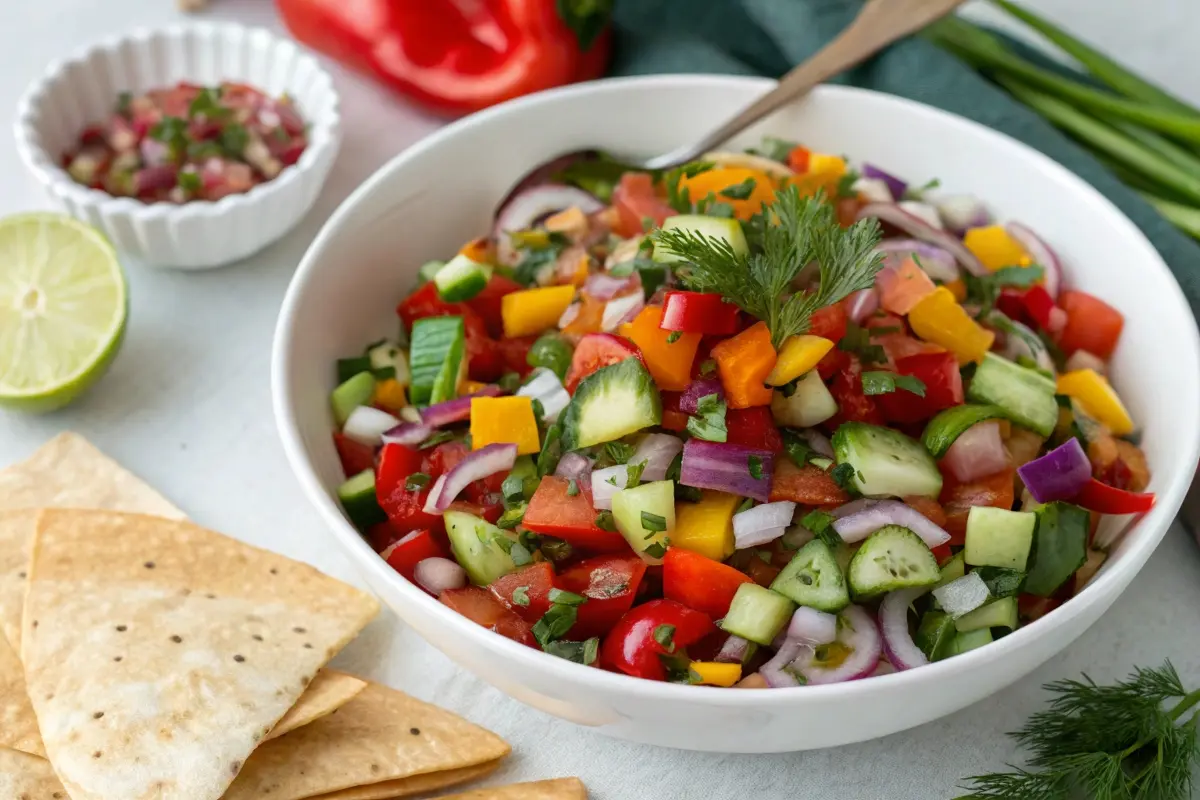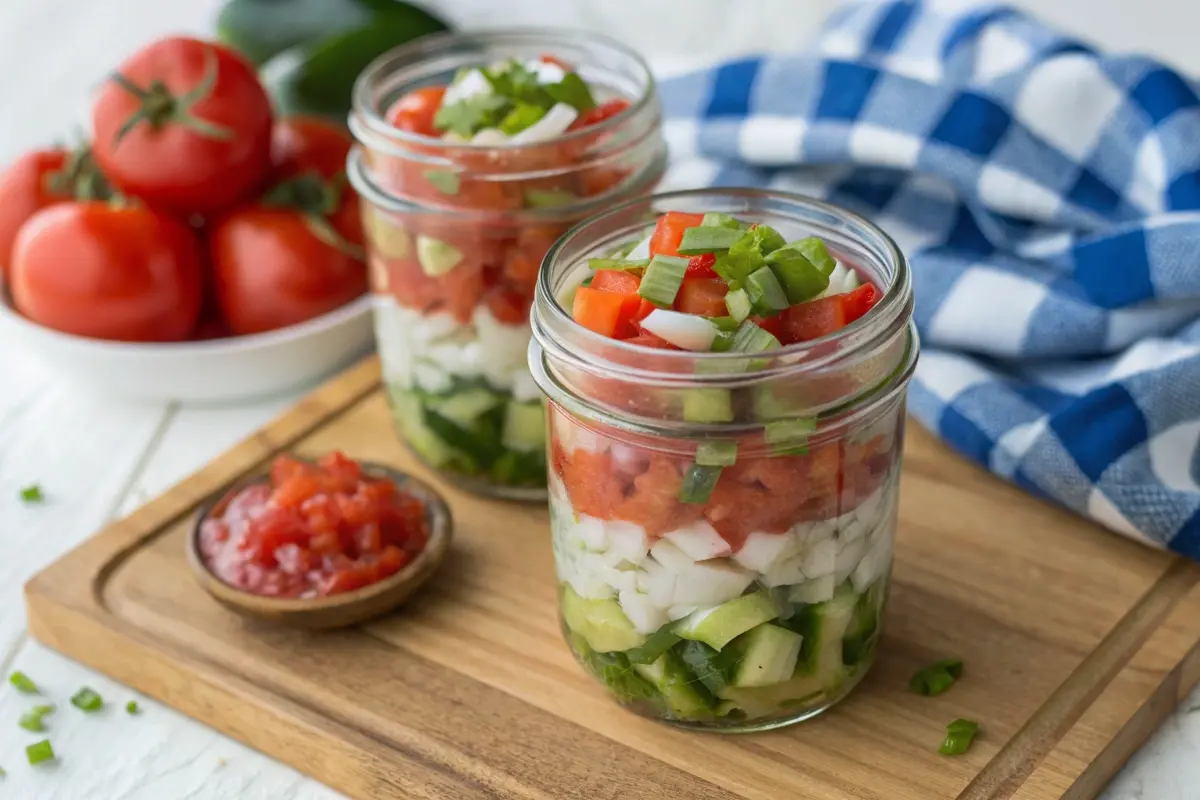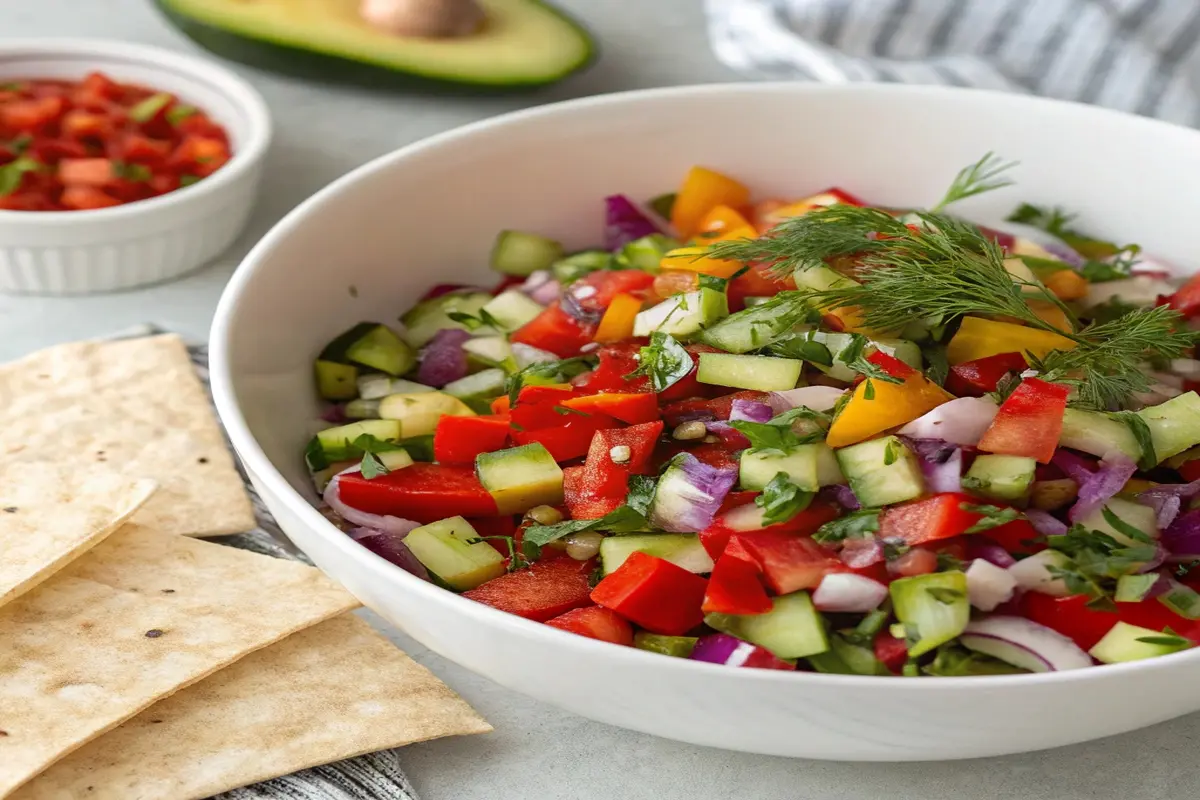Pickle de gallo—a fresh, tangy condiment loved by many—is gaining popularity for its vibrant flavors and health benefits. But if you’re following a vegan lifestyle, you might wonder: Is pickle de gallo vegan? This article dives deep into its ingredients, variations, and preparation methods to ensure that vegans and non-vegans alike can enjoy this zesty dish. Spoiler alert: With a few thoughtful choices, pickle de gallo can be entirely vegan-friendly!

What Is Pickle de Gallo?
Pickle de gallo is a flavorful twist on the traditional Mexican pico de gallo. Known for its refreshing crunch and tangy pickled taste, this condiment combines diced vegetables, spices, and a hint of acidity to create a versatile addition to many dishes.
It’s like a cousin to salsa, but instead of being liquidy, it’s chunky and often brighter in flavor due to its pickling elements. It pairs perfectly with tortilla chips, tacos, or even as a topping for grilled veggies.
“Pickle de gallo is proof that simple, fresh ingredients can come together to create magic in the kitchen.” 🌟
Origins and History of Pickle de Gallo
While traditional pico de gallo has roots deeply embedded in Mexican culinary history, the “pickled” variation has emerged as a modern twist, blending global influences. The acidic tang that defines pickle de gallo likely draws inspiration from pickling techniques popular in various cuisines.
Its evolution showcases how food adapts over time while staying true to its essence: fresh, wholesome, and packed with flavor.
Key Ingredients in Pickle de Gallo
The beauty of pickle de gallo lies in its simplicity. However, its ingredients can vary slightly based on personal preferences or regional styles.
Here’s a typical ingredient list:
- Tomatoes: Fresh, ripe, and diced small.
- Onions: Red or white, adding a sharp bite.
- Cilantro: For that classic herbal note.
- Jalapeños or Serrano Peppers: To bring the heat.
- Lime Juice: Essential for acidity.
- Salt: To balance flavors.
- Optional Additions: Pickling brine, cucumbers, radishes, or even mango for a fruity twist.
Understanding Veganism: What It Means for Food
Defining Veganism and Its Principles
Veganism is more than just a diet; it’s a lifestyle. It involves avoiding animal products in all forms, whether in food, clothing, or other products. For food, this means steering clear of:
- Meat
- Dairy
- Eggs
- Honey
- Any ingredients derived from animals, such as gelatin or casein.
How Veganism Impacts Ingredient Choices
When it comes to condiments like pickle de gallo, vegans must pay attention to hidden non-vegan ingredients. For instance, some pickling brines may contain fish-based additives or sugar processed with bone char.
Analyzing Pickle de Gallo’s Ingredients for Vegan Suitability
Common Ingredients in Traditional Pickle de Gallo
Most of the ingredients listed earlier—tomatoes, onions, peppers, lime juice, and cilantro—are inherently vegan. They come straight from the earth and contain no animal-derived elements.
Are There Non-Vegan Ingredients in Pickle de Gallo?
Here’s where it can get tricky:
- Pickling Brine: Some recipes call for pre-made pickling brines, which may contain fish-based preservatives.
- Sugar: While uncommon, certain recipes may add a touch of sweetness. Processed sugar can sometimes be a gray area for vegans, depending on how it’s refined.
Pro Tip: Always double-check ingredient labels when buying pre-made brines or sugar.
How to Ensure Vegan Ingredients Are Used
Want to guarantee your pickle de gallo is 100% vegan? Stick to fresh, whole ingredients and make your own brine at home. It’s easier than you think and allows you to control every component.
Variations of Pickle de Gallo: Are They Vegan-Friendly?
Pickle de gallo is a versatile dish that adapts beautifully to different flavor profiles. From fiery heat to refreshing sweetness, its variations can suit almost any palate. While most of these twists remain vegan-friendly, it’s essential to pay attention to ingredient choices to ensure they align with a plant-based diet. Let’s explore two popular variations: spicy and fruit-based pickle de gallo.
Spicy Pickle de Gallo and Vegan Concerns
Love turning up the heat? Spicy pickle de gallo is a fantastic option for those who enjoy bold, fiery flavors. Adding diced jalapeños, serrano peppers, or even habaneros can elevate the heat while keeping the dish vegan-friendly. To make it extra spicy, you can experiment with crushed chili flakes, cayenne pepper, or freshly ground chili powders.
However, a common pitfall lies in the use of bottled hot sauces to amplify the spice. While many hot sauces are naturally vegan, some contain non-vegan additives such as:
- Honey: Occasionally used to balance heat with sweetness.
- Worcestershire Sauce: A key ingredient in some spicy condiments, which often contains anchovies.
- Lactic Acid: While typically vegan, lactic acid can occasionally be derived from dairy sources, so it’s worth double-checking the label.
To keep your spicy pickle de gallo 100% vegan, stick to fresh peppers or ensure any hot sauce used is explicitly labeled as vegan. Brands like Cholula, Sriracha (check certifications), or homemade vegan hot sauces are excellent options.
Pro Tip: When adding spice, taste as you go! It’s easy to overdo it, especially with potent ingredients like habaneros.
Fruit-Based Pickle de Gallo and Its Vegan Adaptations
For those who prefer a sweeter and tangier variation, fruit-based pickle de gallo offers a delightful twist. This variation involves adding fruits like diced mango, pineapple, watermelon, or even peaches to the traditional recipe. These natural additions enhance the dish’s flavor, providing a burst of sweetness to balance its acidity and spice.
The good news? Fruits are naturally vegan, making this variation inherently plant-based. It’s also incredibly versatile:
- Mango Pickle de Gallo: Perfect for tropical-inspired meals, pairing well with vegan coconut rice or tofu skewers.
- Pineapple Pickle de Gallo: Adds a tangy sweetness that complements grilled vegetables or vegan tacos.
- Watermelon Pickle de Gallo: A refreshing, hydrating version for summer picnics or as a topping for chilled gazpacho.
The key to nailing a fruit-based pickle de gallo is using ripe, fresh fruits that are firm enough to hold their shape when diced. Overripe or mushy fruits can result in a soggy texture.
While fruits are vegan, some adaptations—such as using pre-made glazes or marinades—could introduce non-vegan elements like honey or non-organic sugar. Always check the labels if you’re using any additional products, or better yet, stick to fresh, whole fruits for maximum control and flavor.
Pro Tip: Add a sprinkle of chili powder or Tajín to fruit-based pickle de gallo for an irresistible combination of sweet, tangy, and spicy flavors! 🌶️🍍
In summary, whether you’re opting for a spicier variation or experimenting with fruits, pickle de gallo remains an incredibly adaptable and vegan-friendly dish. The key lies in selecting fresh, natural ingredients or carefully checking for vegan certifications in pre-made products. With a little creativity, these variations can take your pickle de gallo to the next level, satisfying any craving while staying true to plant-based principles.
How to Make Vegan Pickle de Gallo at Home
Making your own vegan pickle de gallo is both rewarding and foolproof. Follow this simple recipe:
Ingredients:
| Ingredient | Quantity |
|---|---|
| Ripe Tomatoes | 3 cups (diced) |
| Red Onion | 1 cup (diced) |
| Cilantro | ½ cup (chopped) |
| Jalapeños (or Serrano) | 1–2 (diced) |
| Lime Juice | 2 tablespoons |
| Salt | To taste |
| Pickling Brine | ½ cup (vegan-friendly) |
Preparation Method:
- Combine all diced vegetables in a large mixing bowl.
- Add lime juice, salt, and pickling brine. Mix well.
- Taste and adjust seasoning as needed.
- Let it sit for 15–30 minutes to allow flavors to meld.
- Serve fresh as a dip, topping, or side dish.

Nutrition Facts (Per ½ Cup Serving):
| Nutrient | Amount |
|---|---|
| Calories | 20 |
| Fat | 0 g |
| Carbohydrates | 4 g |
| Protein | 1 g |
| Fiber | 1 g |
Popular Store-Bought Pickle de Gallo: Vegan or Not?
When you’re pressed for time, store-bought pickle de gallo can be a lifesaver. But if you’re vegan, it’s important to check the label carefully. Many brands offer pickle de gallo that appears vegan-friendly at first glance, but hidden non-vegan ingredients could sneak in.
How to Read Labels for Vegan Compliance
Reading food labels is an art that every vegan must master. Here’s a quick guide to identifying vegan-friendly pickle de gallo:
- Scan the Ingredients List: Look for animal-based ingredients such as whey, casein, or fish-derived additives.
- Watch for Hidden Sugars: Some sugars may be processed with bone char, which is not vegan. If the label specifies “organic sugar,” you’re in the clear, as organic sugars are processed without bone char.
- Check for Preservatives: Certain pickling brines may include non-vegan preservatives, such as calcium chloride derived from animal sources.
- Look for Certification: Many products carry a vegan certification logo, making it easier to identify suitable options.
Recommended Vegan-Friendly Brands
Several brands cater to the growing vegan market, and their pickle de gallo options are no exception. Here are a few that you can trust:
- Brand A: Known for its organic, plant-based approach, Brand A uses simple, clean ingredients without any animal derivatives.
- Brand B: Offers a tangy pickle de gallo with a vegan certification logo prominently displayed on the label.
- Brand C: Focuses on fresh, local ingredients and guarantees that no animal products are used in its recipes.
“When in doubt, always ask the company directly. Most brands are happy to clarify if their products meet vegan standards.” 🌱
Health Benefits of Vegan Pickle de Gallo
Pickle de gallo isn’t just a delicious condiment—it’s a nutritional powerhouse! When made with fresh, vegan ingredients, it offers a variety of health benefits that align perfectly with a plant-based lifestyle.
Nutritional Breakdown of Vegan Pickle de Gallo
- Low in Calories: With just 20–30 calories per serving, pickle de gallo is a guilt-free addition to any meal.
- Rich in Vitamins: Tomatoes provide vitamin C and antioxidants like lycopene, while cilantro adds vitamin K and other essential nutrients.
- Hydration Boost: The high water content in tomatoes, cucumbers (if included), and pickling brines helps keep you hydrated.
- A Source of Fiber: Onions and peppers contribute to your daily fiber intake, supporting digestion and gut health.
Healthier Alternatives in a Vegan Lifestyle
Compared to other condiments like mayonnaise or ranch dressing, vegan pickle de gallo is naturally low in fat and free from cholesterol. This makes it a heart-healthy choice for anyone looking to enhance their diet with nutritious, flavorful options.
Fun Fact: Adding lime juice to pickle de gallo not only boosts its flavor but also enhances iron absorption, a key benefit for vegans. 🍋
Common Myths About Pickle de Gallo and Veganism
Despite its simplicity, there are several misconceptions surrounding pickle de gallo and whether it fits into a vegan diet. Let’s debunk a few of the most common myths:
Myth: Pickle de Gallo Always Contains Animal Products
This myth likely stems from confusion about the term “pickle,” which some people associate with traditional pickling processes involving non-vegan brines. However, homemade pickle de gallo and most traditional recipes rely solely on plant-based ingredients.
Myth: Vegan Pickle de Gallo Lacks Flavor
Some skeptics assume that vegan versions of classic recipes are less flavorful. But here’s the truth: vegan pickle de gallo bursts with bold, zesty flavors, thanks to its fresh vegetables, herbs, and citrusy notes. In fact, many people prefer the clean, vibrant taste of the vegan version over heavier, animal-based alternatives.

FAQs About Vegan Pickle de Gallo
Is pickle de gallo good for you?
Absolutely! Pickle de gallo is low in calories, high in nutrients like vitamin C and antioxidants, and contains fiber, which supports digestion. It’s a healthy addition to meals, offering flavor without added fats or processed ingredients.
How long does pickle de gallo last?
Homemade pickle de gallo lasts for about 3–5 days when stored in an airtight container in the refrigerator. Its freshness and flavor are best enjoyed within the first couple of days.
What do you eat pickle de gallo with?
Pickle de gallo is versatile and pairs beautifully with many dishes. Enjoy it as a topping for tacos, burritos, or salads, or use it as a dip for tortilla chips. You can also serve it alongside grilled vegetables, rice bowls, or even as a tangy side for vegan burgers.
What’s the difference between pico de gallo and pickle de gallo?
While both are chunky salsas, pickle de gallo includes an acidic or pickling element, such as brine or vinegar, giving it a tangier flavor compared to the classic pico de gallo.
Can pickle de gallo help with weight loss?
Yes! Pickle de gallo is low in calories and packed with fiber and water content, making it a great option for those seeking flavorful, weight-loss-friendly meals.
Is Pickle de Gallo Vegan-Friendly?
So, is pickle de gallo vegan? The answer is a resounding yes—provided you use fresh, plant-based ingredients or carefully select vegan-friendly store-bought options. With its incredible versatility, vibrant flavors, and health benefits, vegan pickle de gallo is a must-try for anyone seeking a zesty, guilt-free addition to their meals.
Whether you’re whipping it up at home or grabbing a pre-made version, pickle de gallo has the power to elevate your dishes while keeping your vegan principles intact. So go ahead, grab those tomatoes, limes, and peppers, and enjoy this delightful condiment with confidence! 🌟
